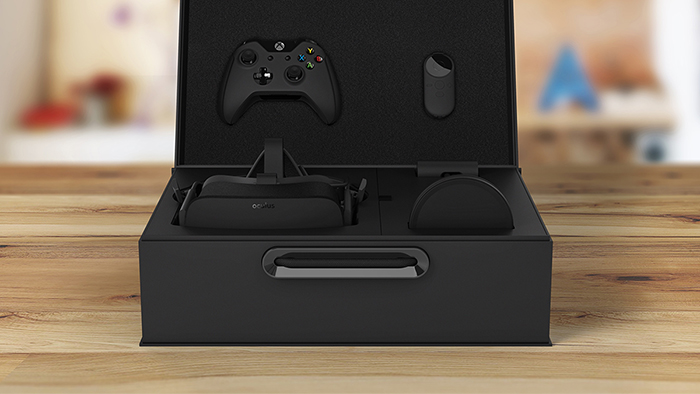
The announcement that Facebook’s Oculus Rift virtual reality product will cost $599 (around £411 at the time of writing) has been met with cries of disappointment.
Oculus announced on its blog that the product is now available for pre-order to 20 countries, including the UK, US, France and Germany and will ship on 18 March.
Hopes that Oculus Rift might be the product that finally carves out a consumer space for virtual and augmented reality may have now been terminally dashed.
The Oculus Rift is actually more expensive than the Xbox One console that it can run on (in addition to high-specification PCs) which cost $499 at launch. However, it comes with a game and official Xbox One controller. Oculus promises "100 titles available by the end of 2016", with 20 games that will be available exclusively on the platform.
Part of the controversy was due to the fact that founder Palmer Luckey was believed to have indicated that the product would cost around $350.
He explained on Reddit that he had "handled the messaging poorly" and had given misleading indications of the price.
For example, he initially explained that the cost of Oculus Rift with a recommended specification PC would cost around $1500, which was mistakenly believed to be the price of the headset.
In an interview, Luckey had previously said that the device would be "roughly in that $350 ballpark, but it will cost more than that."
"I was contrasting $349 with $1500, not our internal estimate that hovered close to $599 – that is why I said it was in roughly the same ballpark," he wrote on Reddit.
"Later on, I tried to get across that the Rift would cost more than many expected, in the past two weeks particularly.
"There are a lot of reasons we did not do a better job of prepping people who already have high end GPUs, legal, financial, competitive, and otherwise, but to be perfectly honest, our biggest failing was assuming we had been clear enough about setting expectations."
Luckey explained that while the device is "expensive" it is purely due to the core technology: "two built-for-VR OLED displays with very high refresh rate and pixel density, a very precise tracking system, mechanical adjustment systems that must be lightweight, durable, and precise, and cutting-edge optics that are more complex to manufacture than many high end DSLR lenses."
But pricing has always been a drawback when it comes to augmented and virtual reality. As Diana Gagnon Hawkins of Interactive Associates writes in the 2013 essay ‘Virtual Reality and Passive Simulators: The Future of Fun’:
"The entrepreneurs interested in offering VR to the public found that the first VR systems that were able to provide an appropriate level of graphics and response time were very costly.
"These higher end systems were too expensive for application in video game arcades, the only existing public interactive venue.
"On average, an arcade video game costs between $3,000 and $10,000, whereas the first commercially available VR systems cost $65,000 (for a single-player Virtuality unit) to over $1 million for multiple-player systems (e.g., Battletech, Visions of Reality, and Iwerks Virtual Adventures)."
As Luckey explains, Oculus doesn’t "make money on the Rift".
He writes that "for the $599 you spend, you get a lot more than spending $599 on pretty much any other consumer electronics devices – phones that cost $599 cost a fraction of that to make, same with mid-range TVs that cost $599.
"There are a lot of mainstream devices in that price-range, so as you have said, our failing was in communication, not just price."
In other words, the limiting factor in virtual reality currently may be above all the inherent cost of building it. It may, in fact, be currently impossible to find a price that is not either prohibitively expensive for consumers or too low for manufacturers.
Microsoft’s HoloLens is set for a Q1 2016 launch to selected developers, with a price of $3000 or roughly £2000. Xbox rival PlayStation is also launching a virtual reality headset, Playstation VR, in the first half of 2016, but it is currently unclear what the pricing will be.
Google, notable in this space also for the stalled augmented reality project Google Glass, attempted to overcome consumer hesitation over virtual reality pricing with the launch of the simplified Google Cardboard.
The search giant developed a design for a set of goggles built out of cardboard, which are sold by both partners of Google and unofficial vendors through Google’s website.
Crucially, most of the hard work in this case is done by the user’s smartphone. This is placed inside the Google Cardboard ‘headset’; the user looks through the goggles and the display of the smartphone provides the images. It comes in roughly around the $20 mark in terms of pricing. KnoxLabs, a market leader, offers a $23.95 headset.
If the majority of virtual reality products are set to remain too expensive for consumers, however, there may still be applications for them in the enterprise and in industry, where budgets may stretch a bit further if the right use-case can be found.
For example, by hooking employees up to virtual reality headsets, training programmes could be implemented more effectively across companies with disparate locations. The technology could also be used by consumer-facing companies, allowing customers to try products before they buy them.
Dr Lisa Su, CEO and President, AMD, said: "In 2016 we will pass a significant milestone as the first consumer-friendly headsets reach market.
"VR is going to be about more than games and has the potential to fundamentally change how we live, work, and play. Imagine a biology class where instead of following along in a textbook students are able to learn how the mind works by "travelling" inside a brain to not only watch but interact with billons of firing neurons.
"These scenarios may sound like science fiction, but they aren’t. GE is already using AMD technology in their "Neuro VR Experience" project that enables a user to enter a full recreation of artist and photographer Robert Wu’s brain…exploring in real-time as he processes thoughts and responds to various stimuli."






